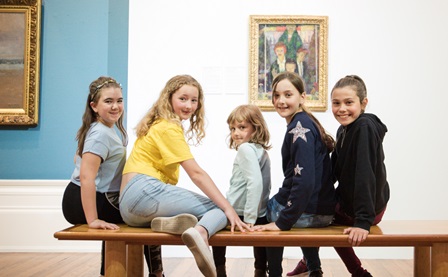Paintings
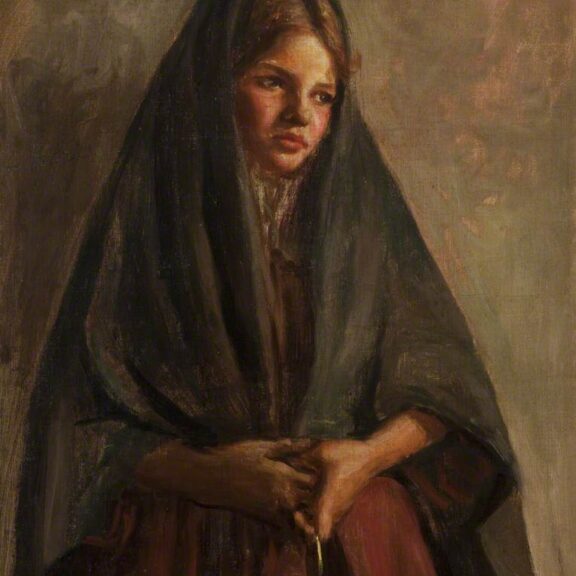
The Half-timer (Portrait of Annie Hill)
Date: 1906-1908
Object number: P2361
Artist: Patti Mayor
Annie Hill was 12 years old when Mayor painted this portrait. She worked as a half-timer at Horrockses cotton mill, splitting her day between work and school.
It was unusual at the time for working women to have their portraits painted. The painting was carried in the Women’s Sunday march in London in 1908 to represent thousands of working women and children like Annie. It played an important role in the campaign for women’s suffrage, helping to demonstrate that women contributed their labour and taxes to the country and should have a say in the country’s politics.
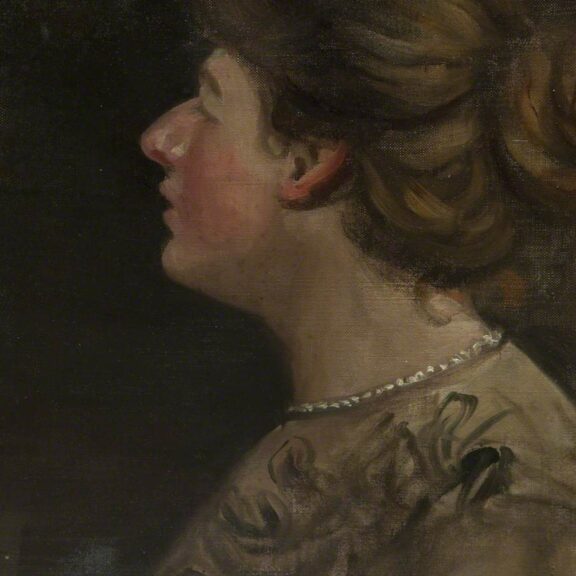
Self Portrait
Date: In the 1920s
Object number: P1179
Artist: Patti Mayor
This self-portrait was probably painted in the 1920s. Patti was a popular Preston born artist who painted the portraits of many local people.
She attended the Slade School of Fine Art, one of the UK’s most prestigious art schools, and was a member of the Women’s Social and Political Union, better known as the Suffragettes
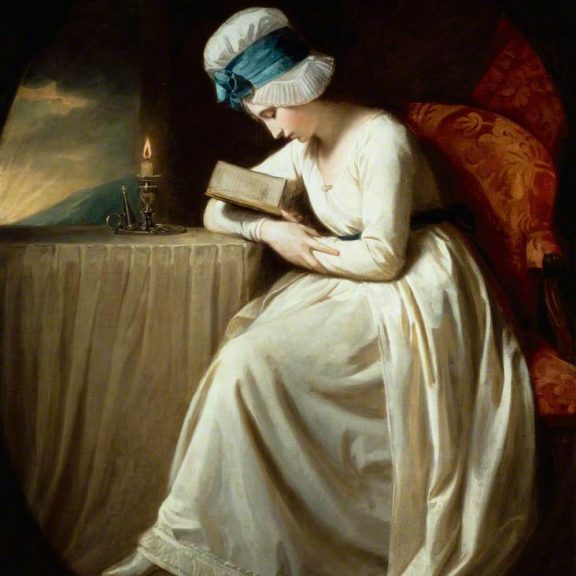
Serena Reading
Date: around 1780-85
Object number: P2365
Artist: George Romney
‘Serena Reading’ shows the heroine from a poem called ‘Triumphs of Temper’ by William Hayley, a close friend of Romney. The poem tells how Serena became so engrossed in a book that she read all through the night. Daylight is breaking and her candle has burnt down. Romney was born near Dalton-in-Furness, Cumbria, but moved to London, where he was the most fashionable portrait painter of his era.
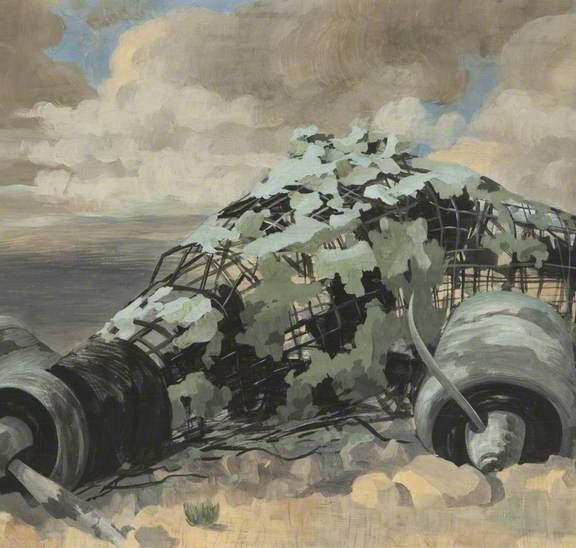
Burnt Out Aeroplane
Date: 1941
Object number: P1111
Artist: John Armstrong
This painting depicts the skeletal remains of a burnt out Italian Savoia-Marchetti SM79 bomber. It was made from a photograph taken after a raid on Castel Benito, an airfield created by the Italian Air Force in Tripoli.
Armstrong was commissioned by the War Artists’ Advisory Committee to make two paintings of crashed aircraft. The other is now at Manchester Art Gallery. Called September 1941, it depicts wrecks of British and German fighter planes on the south-coast.
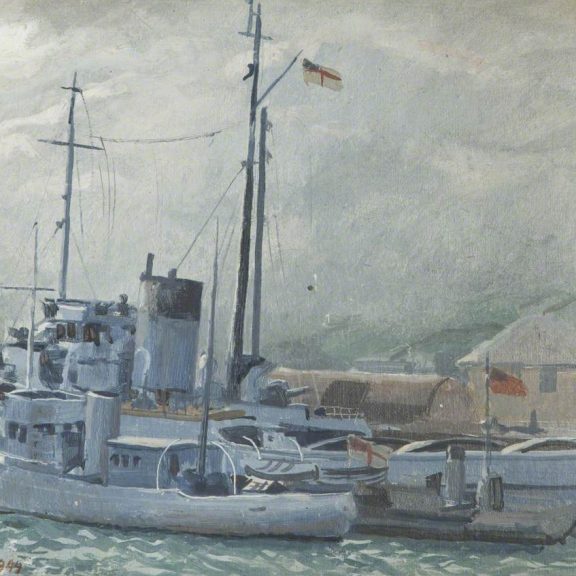
H.M Rescue Tug Samsonia with Water-boat and H.M Yacht Martinetta
Date: 1944
Object number: P1355
Artist: Stephen Bone
At the outbreak of the War, Bone enlisted with a unit at Leamington Spa to work on camouflage designs aimed at concealing important sites like power stations, factories and air fields. He was made a full-time, salaried War Artist in 1943, filling a post vacated by his father Muirhead, who had been the very first War Artist appointed.
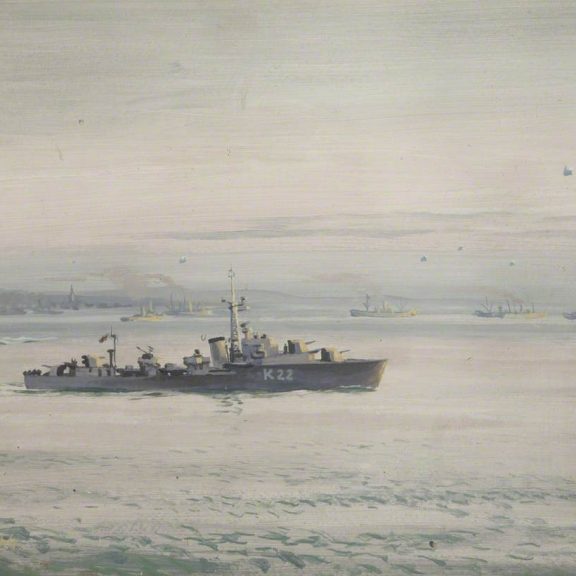
Destroyer Off the Normandy Beaches
Date: 1944
Object number: P1109
Artist: Stephen Bone
Bone specialised in Admiralty subjects, travelling across the country painting Royal Navy bases, ships and submarines. In 1944 he witnessed the Normandy landings, and recorded Naval activity like this Destroyer. The warship used torpedoes and anti-aircraft guns to protected merchant-ship convoys and battle fleets from attack.
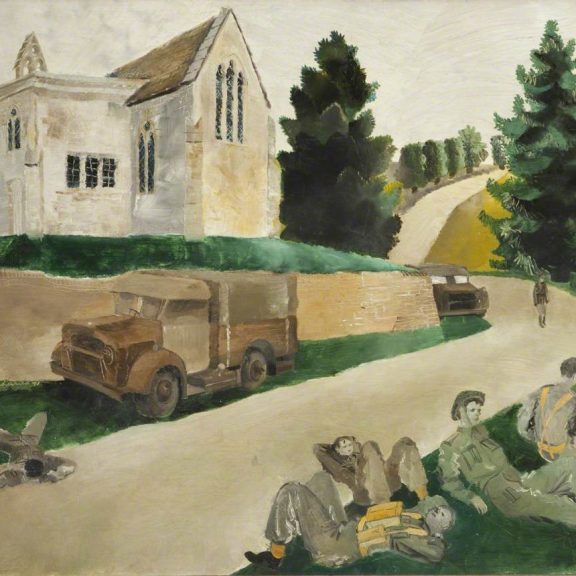
The Minute Halt
Date: 1941
Object number: 2007.118.1
Artist: Albert Richards
Richards was born in Liverpool, his father George was a World War One veteran. He studied at the Royal College of Art in London for three months before being conscripted into the Army in 1940.
After parachute training and promotion to Captain, he parachuted into Normandy on D-Day. Richards was killed in action on the night of the 5 March 1945, when he drove his jeep into an unmarked mine field in Holland. He was planning to make drawings of the retreating German troops. He told his friend that he was going to paint, what for him, was to be ‘the greatest picture of the war’. He was 25 years old.
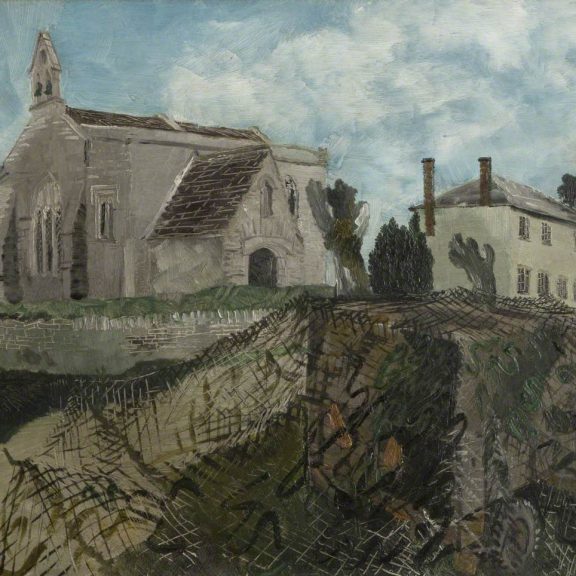
Inglesham Church and Rectory
Date: 1941
Object number: 2007.118.2
Artist: Albert Richards
Richards served with the Royal Engineers, and in 1941 was billeted at Inglesham, a small village in Wiltshire. This painting, and the one to the right, show the beautiful 13th century church of St John the Baptist at Inglesham.
This smaller painting includes the rectory and nearby Church Farm. In the foreground an Army truck is hidden under camouflage netting. It is thought to be a study for the larger painting, The Minute Halt, which includes soldiers resting at the side of the road. Both paintings helped to get Richards’ work recognised by the War Artists’ Advisory Committee. He later gave them to his mother, signing them Bertie, as he was known by his family.
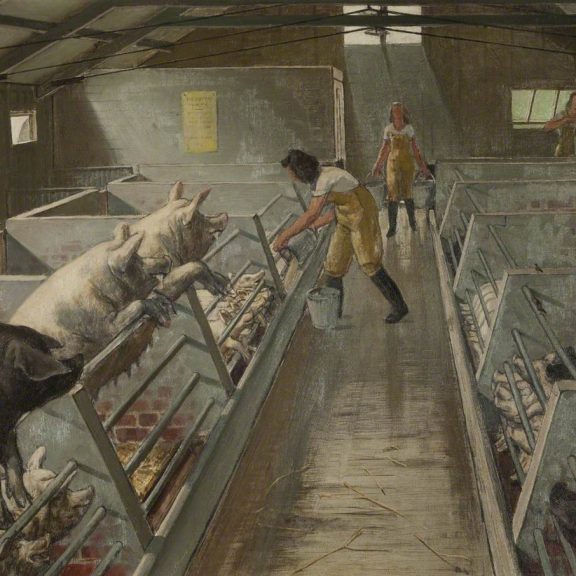
Women’s Land Army at Work
Date: 1940
Object number: P1113
Artist: James Bateman
The Women’s Land Army worked in agriculture, replacing male farm workers who were called up for military service. It was created during the First World War but was reformed at the beginning of the Second World War. By 1944 had over 80,000 members.
Known as ‘Land Girls’, they were critical to Britain’s food production, providing much needed help for farmers across the country.
Bateman came from a farming family in Kendal. He was best known for his paintings of country life and would have been familiar with scenes like this pig shed. The War Artists’ Advisory Committee commissioned artists to document all kinds of war work, at home and overseas.
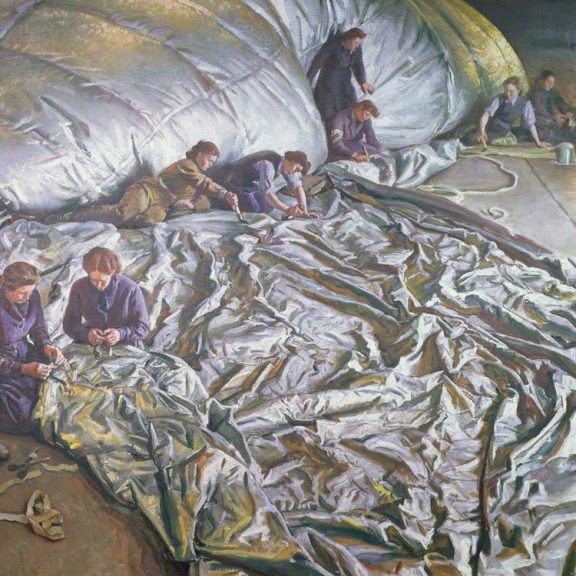
In for Repairs
Date: 1942
Object number: P1116
Artist: Laura Knight
Born Laura Johnson in Long Eaton, Derbyshire, Knight was first given art lessons by her mother before attending Nottingham School of Art at the age of thirteen. In 1903 she married fellow art student Harold Knight and they travelled to Staithes in Yorkshire, before moving to Cornwall.
In 1929, she was created a Dame Commander of the British Empire (DBE). Her work focussed particularly on the circus, the ballet and the theatre. She also painted a number of works depicting Gypsies.
Knight’s painting shows members of the Women’s Auxiliary Air Force (WAAF) repairing a barrage balloon at RAF Wythall, near Birmingham. A quarter of a million women served in the WAAF during the Second World War. They worked in over 110 trades, supporting operations around the world.
As an Official War Artist, Knight was especially interested in representing women who excelled in roles traditionally carried out by men. Her long and successful career paved the way for many female artists.
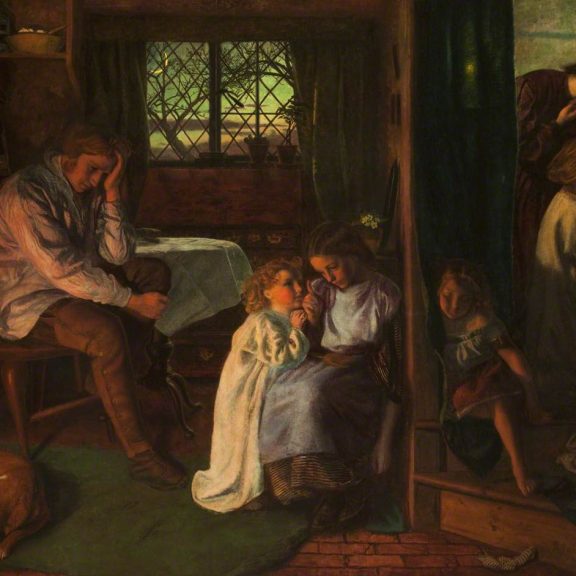
Bed-time
Date: 1862
Object number: P1486
Artist: Arthur Hughes
A father sits looking thoughtful as his children slowly make their way to bed. One girl raises her finger to silence chatter while another child prays. The artist and his own children acted as models. But, there is debate whether the taller figure on the right is his wife Tryphena or his eldest daughter.
Hughes was part of the wider Pre-Raphaelite circle of artists, working with Rossetti, Morris and Burne-Jones occasionally.
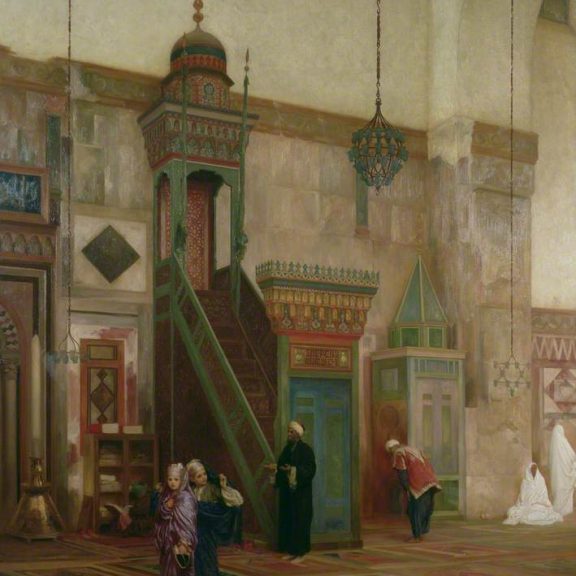
Interior of the Grand Mosque at Damascus
Date: about 1874
Object number: P366
Artist: Lord Frederic Leighton RA
Leighton greatly admired Islamic culture, yet made an error in this painting of the Umayyad Mosque’s prayer hall. Glimpsed on the far left is the mihra, a niche which points worshippers towards Mecca. Instead, Leighton makes the pulpit or minbar the central focus as it is in a Protestant church.
The Mosque was built during the early 700s but suffered terrible fire damage in 1893.
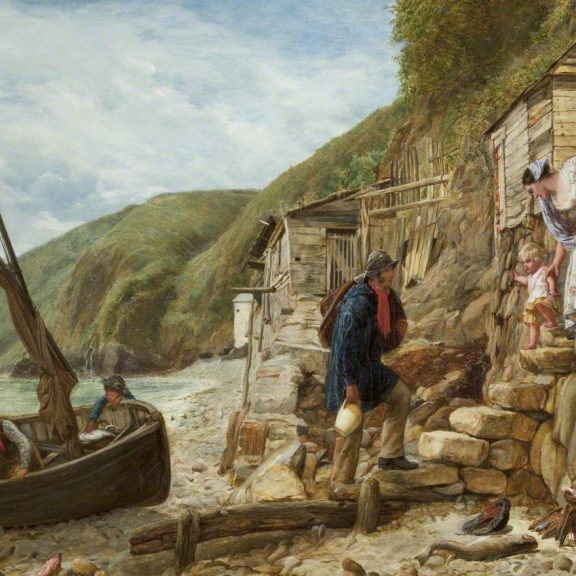
Welcome, Bonny Boat! The Fisherman’s Return at Clovelly, North Devon
Date: 1856
Object number: P298
Artist: James Clark Hook RA
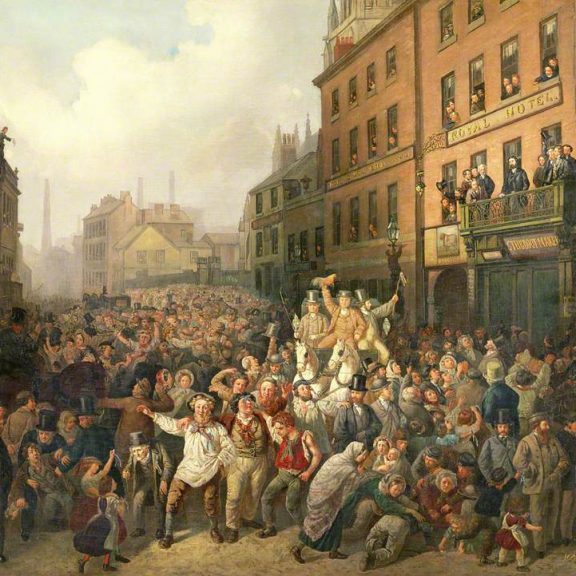
The Preston By-Election of 1862
Date: 1862
Object number: P1690
Artist: Vladimir Ossipovitch Sherwood
Sir Thomas Hesketh, a Conservative, has won the election and stands on the Bull and Royal balcony. A cockerel, the Conservative mascot, is held aloft in victory, but it was claimed that voters were bribed. A man in a smock puts money in his pocket and, at the front, people scrabble for tossed coins.
Sherwood, a Russian, lived Blackburn for four years at the invitation of a local merchant.
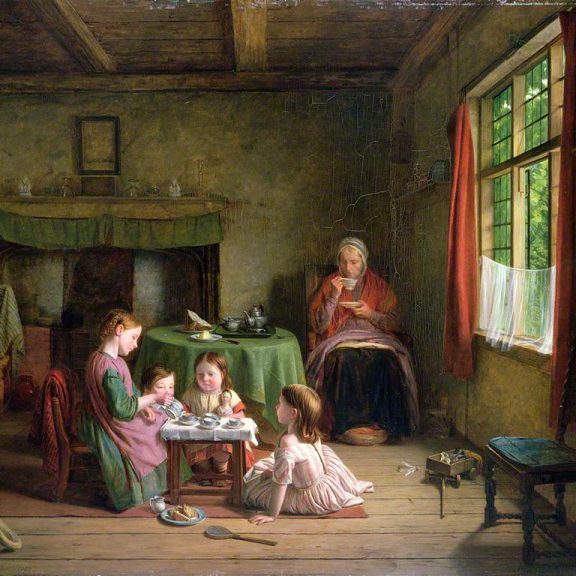
A Tea Party
Date: 1862
Object number: P672
Artist: Thomas Webster RA
The children’s tea party, with its matching crockery and bright, white cloth, contrasts with their rather dreary surroundings. In the corner, an elderly minder quietly sips her own tea.
Webster specialised in gentle, humorous scenes of everyday life, often featuring children. He lived in the village of Cranbrook in Kent alongside other artists who painted in a similar style. They are known as ‘The Cranbrook Colony’.
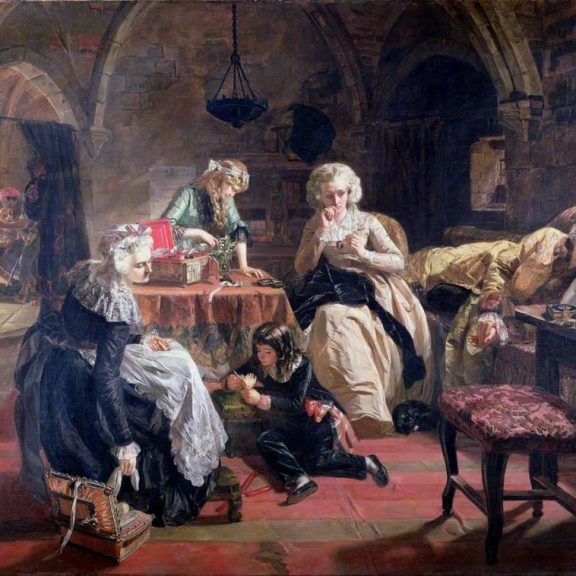
The Royal Family of France in the Prison of the Temple
Date: 1851
Object number: P667
Artist: Edward M. Ward RA
Included in the painting are: Louis XVI, Queen Marie Antoinette, the Dauphin, Dauphiness, and Madam Elizabeth, the King’s Sister
During the French Revolution the Royal family was imprisoned in the Temple, a medieval fortress in Paris. Trying to keep up appearances, Marie Antoinette mends the King’s coat whilst he sleeps. The children and their aunt keep occupied while, through the doorway, jailers play cards and another peers at the family.
The King and Queen were executed in 1793. When this painting was shown in France it made people cry.
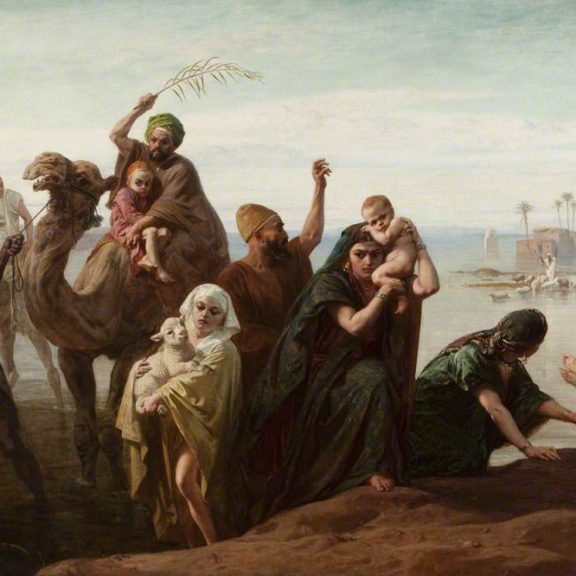
The Sudden Rising of the Nile
Date: 1865
Object number: P257
Artist: Frederick Goodall
The River Nile burst its banks annually making villagers flee from the flooding. Eventually, the waters subsided and everybody could return home. Since the 1970s, the Aswan High Dam has helped to prevent these unpredictable surges.
Goodall travelled to Egypt in 1858 and 1870-1. A major work like this was based on sketches made in Egypt but painted in Britain. Goodall collected Egyptian artefacts to use as props back home, even sheep which he kept in his garden.
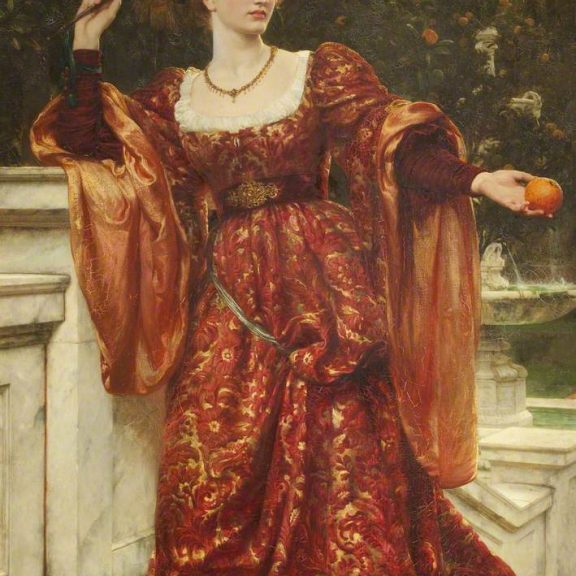
Hesperia
Date: 1887
Object number: P819
Artist: Sir Frank Dicksee RA
Hesperia is one of three sisters from Greek mythology called the Hesperides. They tended a beautiful garden where golden apples grew which gave immortality when eaten. Although she is supposed to be guarding them, Hesperia reaches out to steal an apple for herself. She is sometimes known as Erytheia, ‘the red one’.
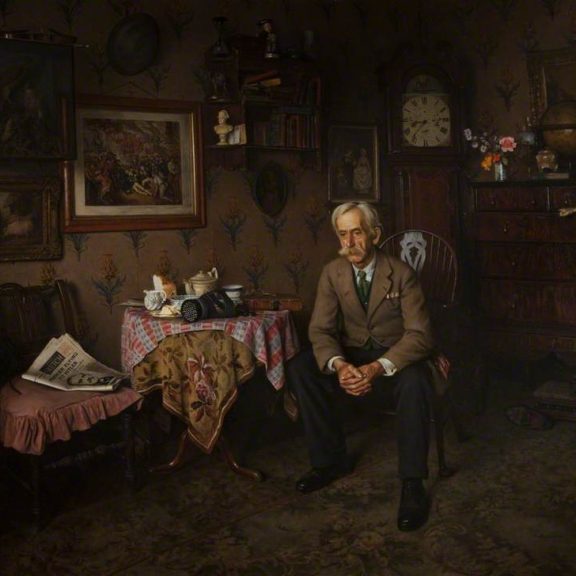
Why War?
Date: 1938
Object number: P845
Artist: Charles Spencelayh
Having fought in ‘the war to end all wars’, this First World War veteran sadly contemplates the onset of the Second World War. Near him lies a new gas mask from Lewisham Council and a newspaper covering Chamberlain’s abortive mission to make peace with Hitler.
Spencelayh’s training as a miniaturist allowed him to build up a story of visual clues in painstaking detail.
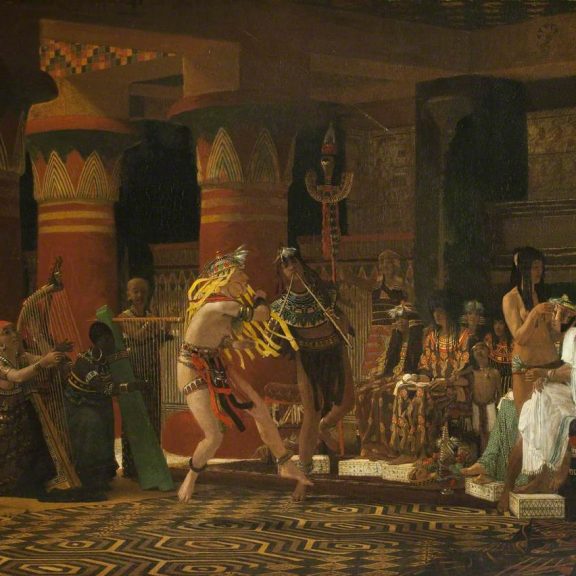
3000 Years Ago
Date: 1863
Object number: P8
Artist: Lawrence Alma-Tadema
This scene depicts a Royal Court, where a Nubian ambassador – dressed in white – is entertained by a dancer and musicians. To his right sits the host, a priest called Phtames, a scribe to the god Ptah at Memphis.
The subject of this painting was suggested to the artist by a wall painting he saw during a visit to the British Museum in 1862.
Many of Alma-Tadema’s paintings offer a glimpse into the ancient past. He used historical sources and the most up-to-date archaeological findings when researching his paintings. The harp in the painting is drawn from an example he saw at the Louvre, in Paris, and the chairs from the British Museum.
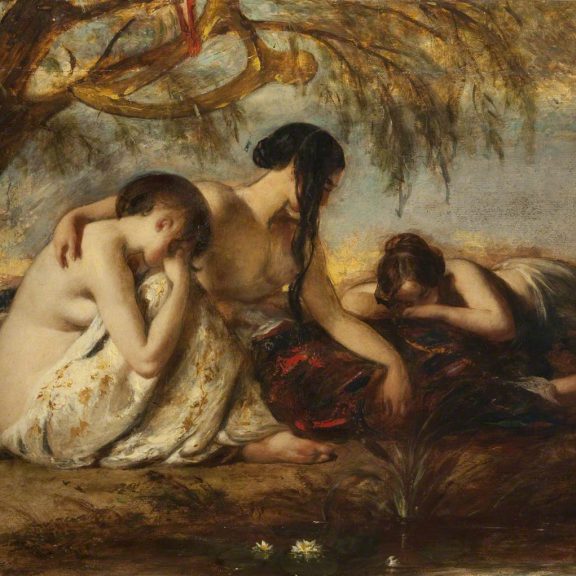
By the Waters of Babylon we Sat Down and Wept
Date: about 1848
Object number: P218
Artist: William Etty
Taken from the 137th psalm, this biblical scene depicts a group of Jewish captives mourning their exile from Jerusalem following the Babylonian conquest of the city.
Born in York, Etty was able to go to London and enter the Royal Academy Schools due to the financial support of his uncle. Inspired by artists like Rubens and Titian he specialised in painting nudes, and in doing so became one of the most controversial artists of the Victorian era.
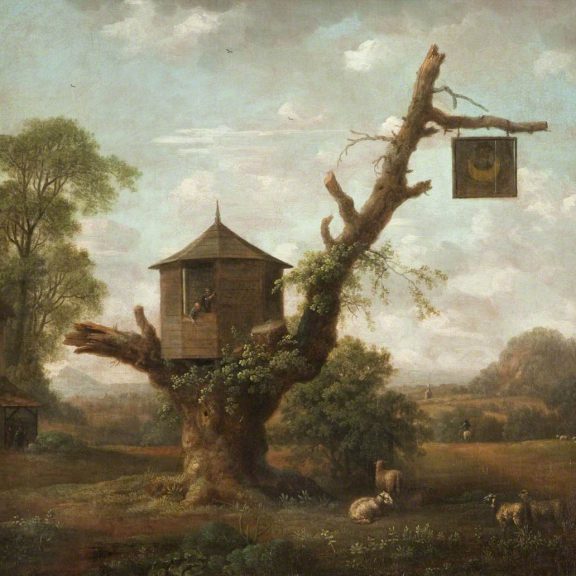
The ‘Man in the Moon’ Inn
Date: about 1785
Object number: P1405
Artist: Anthony Devis
Did this remarkable pub in a tree really exist? We are not sure. Devis may have copied the scene from a Dutch painting. The behaviour of some figures is bawdier than Devis usually depicted and more in keeping with the Dutch style.
Preston-born Devis was half-brother to the portrait painter Arthur. Anthony was a very successful landscape painter who settled in Surrey in 1780. If the pub did exist, it may have been there.
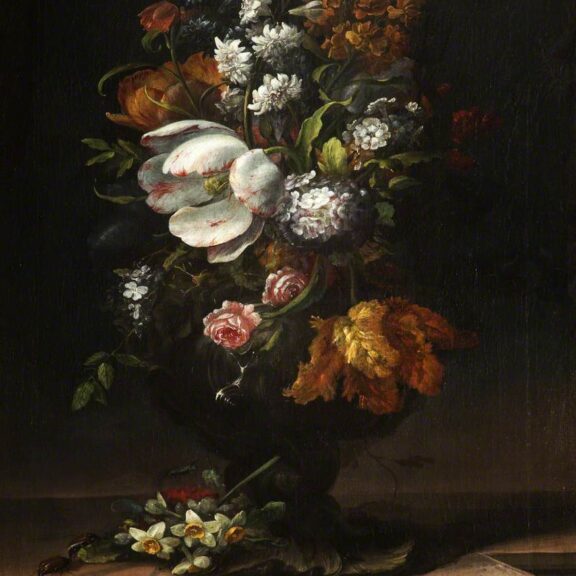
Summer Flowers
Date: 1695
Object number: P828
Artist: Rachel Ruysch or a follower
Ruysch was one of the most celebrated artists of the Dutch Golden Age and appointed court painter. Her scientific knowledge of flowers was learnt from her father, a professor of botany. This painting is typical of Ruysch’s meticulous detail set against a dark background. However, she only completed about 100 paintings herself and her work was often copied.
This remarkable artist also had 10 children with her husband, portrait painter Juriaen Pool.
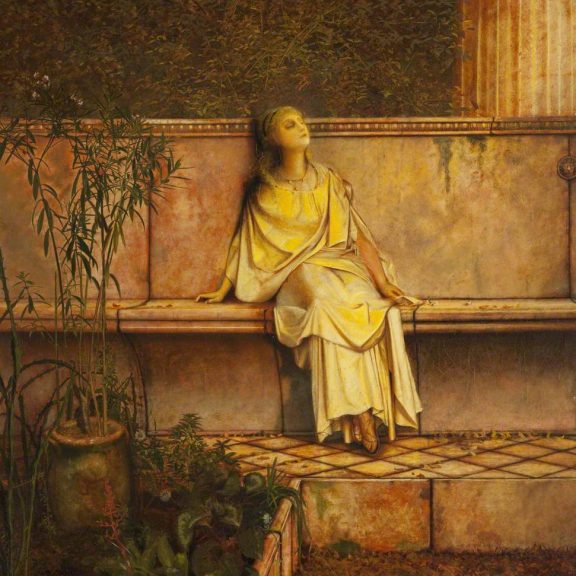
Golden Visions
Date: 1870
Object number: P269
Artist: John Atkinson Grimshaw
John Atkinson Grimshaw was born in Leeds in 1836. He had no formal art education, but most likely learned to paint through visiting galleries. He had his first exhibition in Leeds in 1862.
Grimshaw began by painting nature scenes but his repertoire soon expanded to cover fashionable women, scenes from ancient Greece and Rome and townscapes. However, he is most famous for his moonlight scenes.
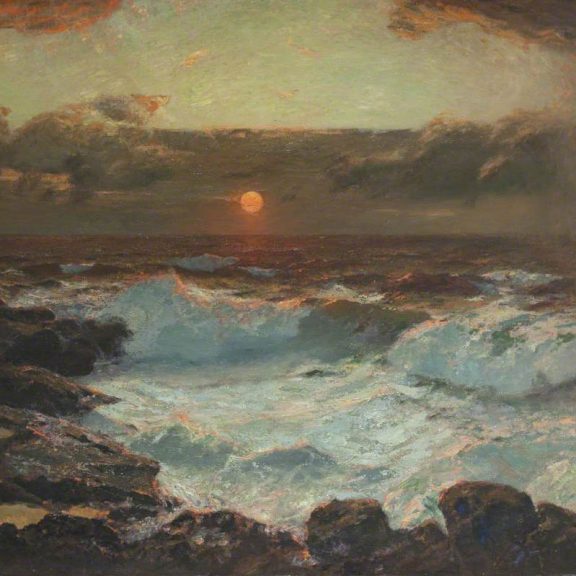
Sunset at Land’s End
Date: 1910
Object number: P448
Artist: Julius Olsson
Olsson is one of only a few artists who specialised in pure sea painting, in particular twilight and moonlight scenes. He was born in London but moved to St Ives, Cornwall in 1888. Olsson described sea painting as one of the most difficult subjects for a painter.
‘For one whose heart draws him to the sea, in the first place must have an exceptionally retentive memory, and be able to grasp in a few moments the effect of the ever-changing movements of the sea and sky; he must have a delicate and subtle sense of colour, and have the ability to place the main features of his impression on the subject of the subject on the canvas with a few strokes of the brush, and beside this, he must be prepared to face a brave fight with the elements, which will frequently be against him.’
Julius Olsson, 1934
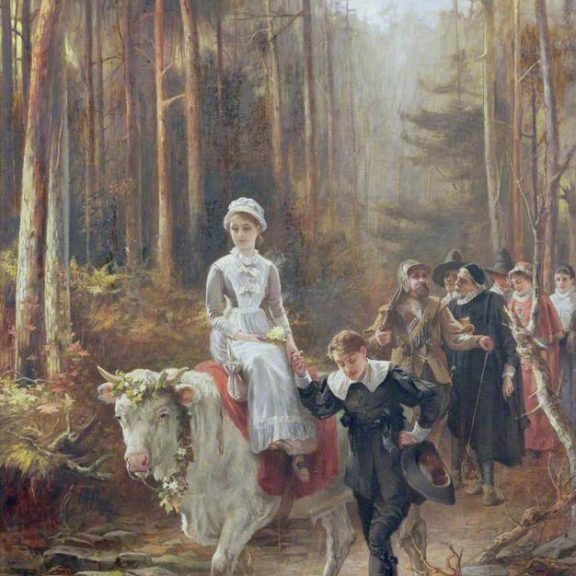
Priscilla – the Courtship of Miles Standish
Date: 1885
Object number: P468
Artist: Laslett John Pott
Miles Standish (1584-1686) was the Captain of the settlement of Plymouth Colony in what is now Massachusetts, USA. The story depicted here appears in a long poem of 1858 written by the American poet, Henry Wadsworth Longfellow (1807-1882).
According to Longfellow, Standish asks his friend, John Alden, to woo Priscilla on his behalf. Alden, although in love with the girl, agrees out of duty to his friend. Priscilla, unimpressed that he will not pay court for himself, rejects Standish. Furious at this and believing himself to have been betrayed by Alden, he leaves for war against the ‘Indians’. In his absence, Alden and Priscilla fall in love and, hearing of Standish’s death, they decide to marry. This news proves to be false, however, and the Captain returns to attend the wedding and beg forgiveness for his anger. The three are then reunited as friends. The villagers crowd round Standish, overjoyed at his safe return and eager to hear of his adventures. Meanwhile, Alden leads his bride from the ceremony through the Massachusetts woods, riding upon his ‘snow–white bull’.
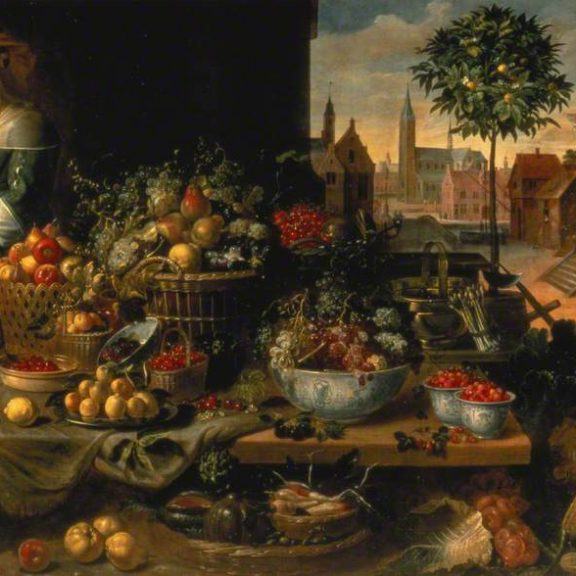
A Fruit Stall
Date: 1640
Object number: P1598
Artist: a follower of Frans Snyders
Frans Snyders was a Flemish artist, born in the city of Antwerp, now in modern Belgium. He specialised in still-life paintings of fruit and game, occasionally working in collaboration with other artists.
Around 1615 Sydners was commissioned to paint a group of paintings known as The Four Markets – which now hand in the Hermitage Museum in St. Petersburg. Snyders’ Fruit Stall resembles the Harris’s closely and, for many years, our picture was thought to be a copy. However, the differences are significant enough for it now to be considered an independent work by an artist influenced by Snyders, possibly even trained within his workshop. It certainly dates from well after 1615, the clothing of the two women suggesting the 1640s.
The prominence of the building on the right (which is most likelt a guild hall for butchers) suggests that this painting may have been commissioned for that building.
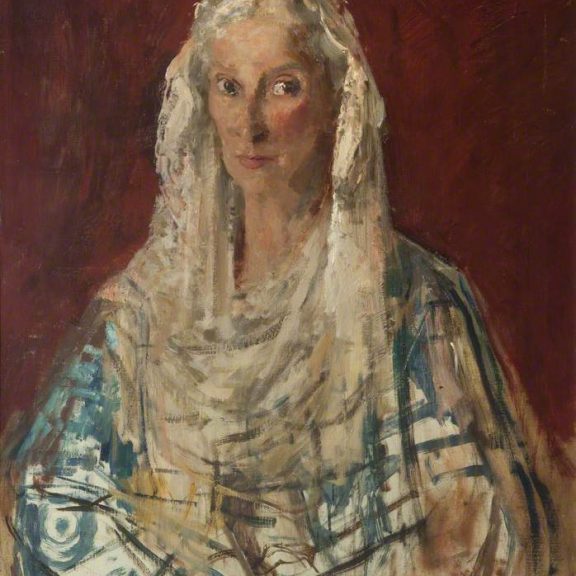
Dorelia
Date: 1959
Object number: P1616
Artist: Augustus John
This is a portrait of the artist’s second wife, Dorothy McNeill, known as Dorelia, or Dodo. The couple met in 1903 and began a passionate affair in which Dorelia lived with both John and his first wife, Ida Nettleship, whom he had married in 1901. This ménage à trois continued until Ida’s death in 1907. Dorelia and John later married, living together, despite his numerous affairs, until the painter’s death in 1961.
A brilliant draughtsman, John worked mainly as a portraitist, including the Queen and Winston Churchill amongst his sitters. Despite his connections with society, he and his family lived a bohemian lifestyle, rather like early hippies or New-Agers, wearing gypsy style clothing, even living for a time in a gypsy caravan. His interest in gypsies was serious and he sought them out wherever he went. He campaigned for gypsy and traveller rites and was elected president of the Gypsy Lore Society in 1936.
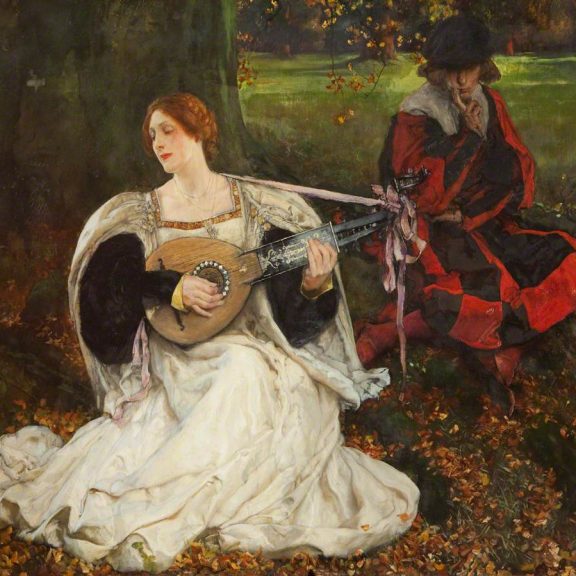
Fair is My Love
Date: 1900
Object number: P1
Artist: Edwin Austen Abbey
Edwin Austen Abbey was an illustrator and painter. He was born in Philadelphia, on 1 April 1852. At the age of fourteen he took up drawing lessons. From around 1871, he prepared drawings for Harper’s Weekly and Harper’s Monthly, as well as for books such as Charles Dickens’ Christmas Stories of 1876.
His work was inspired largely by that of the English illustrators of the 1860s. He developed a pen and ink style characterised by compositions that were created to resemble architecture; glittering light effects; attention to detail; and an insight into human emotions.
In December 1878, Harper’s magazine arranged for Abbey to travel to England in order to absorb its ambience directly. He planned to stay for a year, but remained in England for most of the rest of his life.
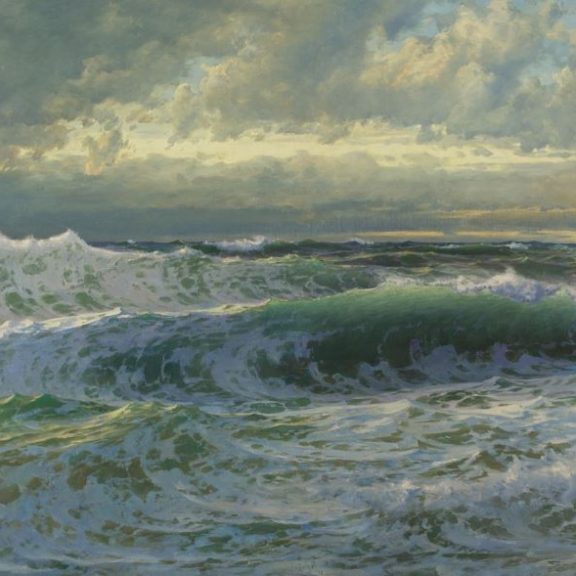
After A Gale
Date: 1903
Object number: P484
Artist: William Trost Richards
This oil on canvas is titled After A Gale, it was painted by William Trost Richards (1833-1905) in 1903 and purchased by the museum in the same year. Trost was an American artist from Philadelphia who was influenced by John Ruskin, and the Pre-Raphaelites. In the 1870s he began to devote his attention to marine painting and travelled to Europe in search of dramatic coastal scenery – including the UK, France and Norway.
The painting was selected by the Harris LGBTQ group to feature in the LGBT+ History Month Trail in 2019 and 2020. Phil, a member of the group, wrote the following interpretation inspired by their response to the painting:
“I have chosen this painting because it is one of the finest in the Harris collection. For me it is also an unwitting symbol of the unwritten history of gay culture and the sea. Churchill famously referred to the Navy as ‘nothing but rum, sodomy and the lash’ – even though homosexuality was illegal in the military until 2000.
Pirate ships were another male dominated, maritime world. Before the Reformation, people attracted to others of their own gender might have joined a monastery or nunnery. From the 1550s men who didn’t fit in might have been attracted by piracy. It was a masculine world in which same sex relationships were tolerated and celebrated.”
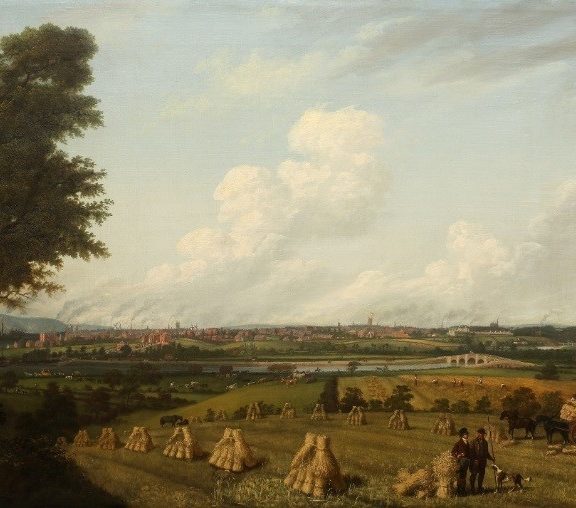
View of Penwortham from Preston
Date: c.1820
Object number: PRSMG: P1618
Artist: Artist
The sunny harvest scene in the foreground is a picture of rural life as it had been for centuries. Across the Ribble and Penwortham Bridge looms the darker atmosphere of industrial Preston, with its rapidly expanding streets of mills and houses.
In the early 19th century, farming was being relocated from the town centre to the green spaces outside its boundaries. The desperate need to provide housing for the rapidly expanding population meant that many of the narrow garden plots and town fields, used for centuries to grow crops, were now packed with dangerous, cramped and unsanitary houses.
Windmills are visible in the distance – Preston was an important corn-milling centre at this time – but smoking chimneys now dominate the skyline
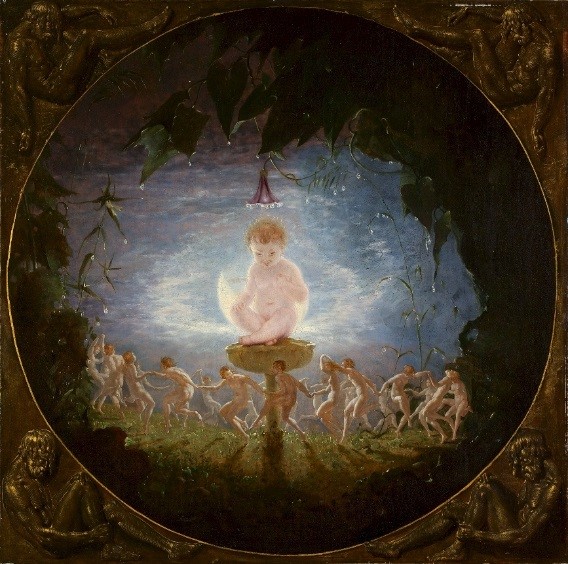
Puck
Date: 1841
Object number: PRSMG: 2011.88
Artist: Richard Dadd
Puck was painted by Richard Dadd, the infamous Victorian artist best know for his ‘fairy paintings’. Puck is a character from Shakespeare’s play A Midsummer Night’s Dream. The painting once belonged to Preston solicitor Thomas Birchall. After many years the painting has returned to Preston and is now part of the Harris’ permanent collection. This is an oil painting on canvas.
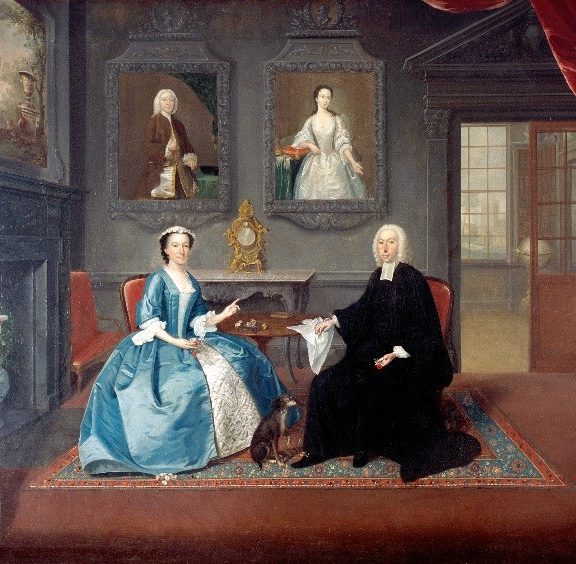
The Rev. Streynsham Master and his Wife, Margaret, of Croston, Lancashire
Date: 1742-4
Artist: Anthony Devis
The Harris holds an important collection of paintings by artists who were born or who have lived in Lancashire that dates from the 18th century to the present day. The collection includes mostly portraits and local landscapes.
Arthur Devis was born in Preston, he was the son of a cabinetmaker. Although he lived mostly in London, he maintained strong links with Lancashire and received a number of commissions from local families.
This portrait of the Rev. Streynsham Master, Vicar of Croston, and his wife Margaret is a type portrait known as a ‘conversation piece’. Fashionable in the 18th century, they show family groups or friends in informal domestic or rural settings.
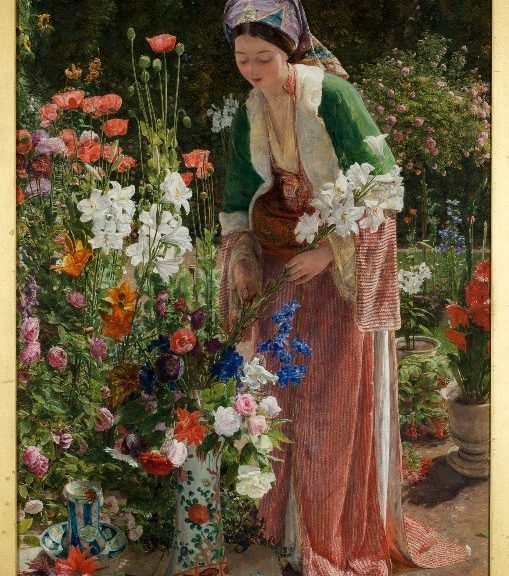
In the Bey’s Garden
Date: 1865
Artist: John Frederick Lewis
The first major addition to the Harris’ art collection was a bequest from Preston lawyer Richard Newsham in 1883. This collection of over one hundred oil paintings and watercolours by prominent Victorian artists, is still considered the core of the collection today.
A favourite painting in the Newsham Collection is In the Bey’s Garden, painted in 1865 by John Frederick Lewis. The woman in the painting is meant to be the wife of a Bey, or Turkish provincial governor but is actually the artist’s wife, Marian.
Lewis travelled widely and lived in Cairo for 10 years. Back in Britain, he continued to paint Orientalist works for the rest of his career.
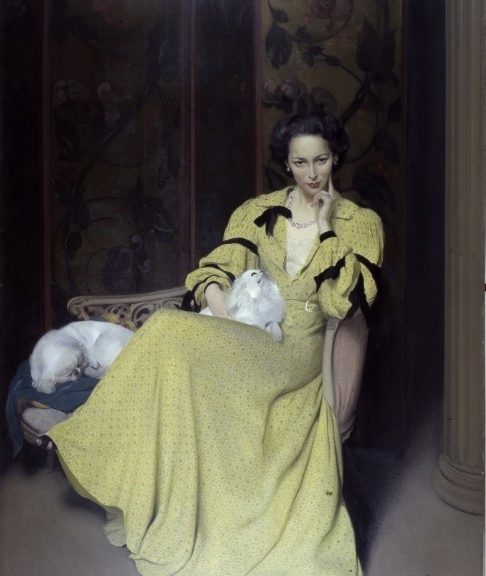
Pauline in the Yellow Dress
Date: 1944
Artist: Sir James Gunn
There are over 800 oil paintings and over 6,000, watercolours, drawings and prints at the Harris. The collection includes 18th century portraits and landscapes, Victorian and 20th century paintings, prints and drawings by British and European artists from around 1400 to the present day, and work by regional artists.
This portrait of Pauline Gunn, the artist’s wife, caused a sensation when it was first displayed at the Royal Academy in London. It was voted picture of the year and described as ‘the Mona Lisa of 1944’ by the Daily Mail.
The Harris purchased the painting. Visitors flocked to see her when the painting first arrived in Preston. They were captivated by her gaze and sometimes outraged by the yellow dress, made with extravagant amounts of fabric during war time rationing. At the time, Gunn was one of Britain’s most popular portrait painters. His seemingly effortless style brought him numerous commissions, including the Royal Family, prime ministers, and leading artistic and literary figures of the day.
Today, Pauline in the Yellow Dress is still our most popular painting.
